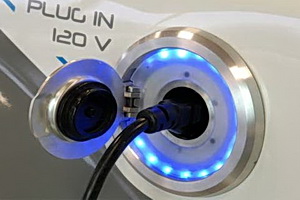
What a difference a decade makes.
After GM pulled the plug on its groundbreaking EV1 in 1999, it seemed like the goal of driving mass-produced electric cars had also been flushed down the drain.
Fast forward ten years and we have two plug-in vehicles being released by major manufacturers that are targeted towards mainstream car buyers, the Chevrolet Volt and Nissan Leaf, with models from Toyota, Ford, Mitsubishi, Honda, and BMW coming in 2012.
For attendees of this week’s Plug-In 2010 Conference, held in San Jose, California, the embrace of electric vehicle technology by major manufacturers is a welcome success, yet veterans of this emerging movement caution against claiming victory too soon and acknowledge that there is much work to be done.
Now in its 3rd year, the Plug-In Conference brings together automobile manufacturers, component suppliers, electric utilities, government agencies, researchers, and the public to exchange ideas and gather information related to plug-in vehicles and electric transportation in general.
This new found interest in electric cars has benefited from several converging trends that will hopefully lead to more long-term success: improved battery and charging technology, increased societal environmental consciousness, popularity of hybrid gas-electric cars, and support from key partners like utilities and local governments.
Still, many challenges remain, including developing adequate charging infrastructure in homes, offices and public places; making sure the power grid can adequately deal with the increased load demand from widespread adoption of electric vehicles; and producing electric power in more clean and renewable ways.
There will also be many questions facing future customers, from practical questions about what kind of charger to buy to worries about “range anxiety” and running out of juice while on the road. The fact that there are two different types of plug-in cars being produced creates additional potential for confusion among consumers. Hybrid plug-ins, like the Chevy Volt, have shorter electric-only range, but can switch to an internal combustion engine for power when the battery runs low, while electric-only plug-ins, like the Nissan Leaf, can go farther on a single charge, but can also leave the driver stranded if the battery runs out.
There is also disagreement over the best strategy for rolling out this new technology. Both the Volt and Leaf will initially only be available in select markets, which limits the potential customer base and could create resentment from those who are left out. On the plus side, this gradual deployment will allow for more easy correction of mistakes and application of lessons learned.
And then there is the question of what happens if few people end up buying these new plug-in cars. While Nissan and Chevrolet have taken the more risky route of launching all new plug-in platforms, Ford has decided to play it safe by electrifying its most popular existing models, including the Focus and Transit Connect.
Toyota has taken a similar route with its plug-in Prius model, which is now being tested throughout the country, and BMW is planning on producing its ActiveE concept, which is based on the 1 series platform. By sharing design and manufacturing with existing models, there are not only advantages in terms of development cost and time, but it won’t be nearly as costly to shift production to more conventional gasoline engines or hybrid gas-electric technology should the electric version not catch on.
Even with these uncertainties, the level of interest by manufacturers as well as the public points to the viability of electricity as a fuel for automobiles. Over 50,000 people have reportedly placed pre-orders for the Nissan Leaf and Ford predicts that up to 25% of its fleet will utilize some form of electrification by 2020.
Whether we are witnessing the beginning of a paradigm shift in automotive transportation, or just the creation of a successful niche market, the hope is that many people will go out and buy a plug-in vehicle. As Chelsea Sexton, who worked on the EV1, remarked, “The only electric vehicles that matter are the ones that get bought and used, whatever they may look like.”


Leave a Reply